Once the exclusive domain of the military, infrared imagers are now taking commercial applications by storm, thanks to lower prices and better technology. In fact, it seems the only limit to this flourishing technology is our imagination.
“Thermal imaging will soon become ubiquitous and part of our everyday lives, like the adoption of PCs, cellphones and GPS before it.” That’s the prediction from Tim Fitzgibbons, consumer electronics pioneer and co-founder of Seek Thermal Inc., a startup IR specialist company that has just launched the latest thermal camera for smartphones.
The excitement for thermal imagers is being felt all over the industry, as companies both in and out of the IR arena are refocusing their research and development teams in a bid to find the next hot application.
IR imaging can be used as both a predictive and preventive tool, which makes it highly diverse. From medical imaging, inspection and diagnostics, and environmental monitoring to the huge markets in military and surveillance, thermal imaging has long been a vital tool in many fields.
But many believe that there are great opportunities for new applications yet to be conceived. “Although thermal has been around for over 65 years, public exposure to its capabilities is new. The price point is enabling people to uncover exciting new applications daily, all of which were previously unobtainable or unrealistic,” Fitzgibbons said.
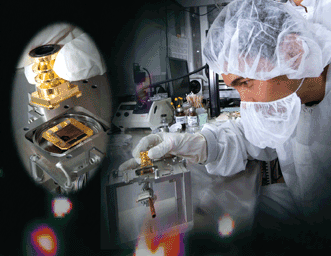
Lockheed Martin Santa Barbara Focalplane is a world leader in the design, custom development and manufacture of focal plane array detectors, designing and manufacturing the highest-quality InSb focal plane arrays in many configurations, from linear to large staring formats.
Experts at market analyst firm Yole Développement are in no doubt as to the significance of the IR imaging phenomena. “I remember attending a Samsung technology scouting event a few years back, and if you were not doing 3-D then, you were out. Now this year, things are different. Infrared has suddenly appeared on Samsung’s map. When a technology starts turning the head of a $200 billion giant, this must say something about its market potential,” said Pierre Cambou, activity leader for MEMS and Imaging.
Consumer IR imaging is just at the start, but with the benefit of the novelty effect potentially wearing off after a couple of years, Cambou highlights the importance of sustaining impetus for seeking out new applications.
“For the trend to keep its momentum, it will be necessary that new use cases come into play. We are relatively confident that this will happen,” Cambou said. “Thermal infrared gets a key advantage when it comes to interactions with humans. This is exactly what startups like Irysis, Pyreos or Irlynx are developing.”
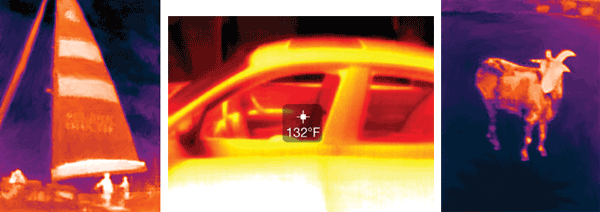
With applications in home improvement, personal safety, hunting and boating, and first response equipment, Seek Thermal is optimistic about the future of consumer IR imaging.
At Fluke Corporation, the traditional customer base for its thermal imagers has been users of industrial test and measurement equipment. But with users constantly asking for new applications, the business has recently expanded its offerings to include cameras and optics designed for more research and development use.
“The greatest challenge to finding broader applications is having the time to think about where and how to use the technology. Infrared imaging can be used anywhere where heat, or lack of heat, may indicate a state change or a change in condition. It just takes time to figure out what the thermal signature means from a practical standpoint and how to make proper use of this analysis,” said Michael Stuart, Fluke senior manager of Thermography Services and a Level III thermographer.
Cost and performance improve
IR technology is following Moore’s law to a certain extent. The result is, and will continue to be, imaging systems that are smaller, less expensive, consume less power, are easier to use and offer better overall performance.
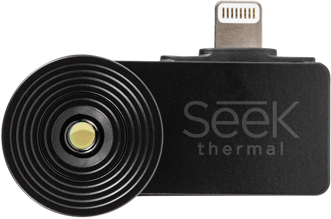
Thermal imaging add-ons to smartphones such as this Android are expected to reach sales of tens of thousands in 2015, according to a Yole Développement market report carried out in 2014.
“In the last 10 years, Fluke has seen more than tenfold increase in the use of thermal imagers. There are several reasons for this. A primary driver is decreased cost and increased affordability,” Stuart said. “Professional-grade infrared technology is now available to users who previously would have been priced out of the market.”
As well as cost, the performance of IR imaging – particularly for consumer applications – has surprised many traditional users of IR imaging.
Resolution has reduced above the range of QCIF (Quarter Common Intermediate Format), typically 200 × 150, and sensitivity (noise-equivalent temperature difference) is now more in the order of 0.1 K when it used to be more than 0.2 K. And while the race between piezoelectric sensors and microbolometers entering the consumer space is not over, the first round goes to microbolometers.
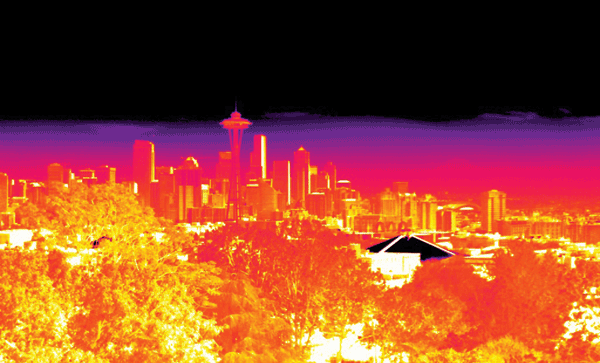
An IR image of the Seattle skyline shows an excellent level of detail at varying distances; it was taken with a stock handheld Fluke TiX1000 1024 × 768 FPA IR camera and a standard FOV lens.
“In the mid-1990s, a 50-µm uncooled microbolometer pixel was required to resolve a scene temperature difference of a tenth of a degree or less,” said Seek Thermal’s Fitzgibbons. “Today, thanks to some amazing advances, we are able to do that with a 12-µm pixel.”
The military market is trending toward longer operating ranges, with larger arrays for increased resolution and standoff. With mixed-mission roles, such as targeting and nontraditional intelligence surveillance and reconnaissance, much more is expected from a sensor, and bolometers can’t quite keep up in terms of sensitivity and speed.
“Extremely fast optics are required for uncooled detector technologies, which leads to unmanageable optics size and weight for longer-range applications,” said Mark Goodnough, chief scientist at Lockheed Martin Corporation’s Santa Barbara Focalplane facility.
Researchers exploring a wide range of group III and V detector materials for mid- and long-wave solutions have come up with nBn (n-type absorber, Barrier, n-type contact) and strained layer superlattice detectors, which provide higher operating temperatures with multifunction capabilities that yield smaller pixels with larger formats.
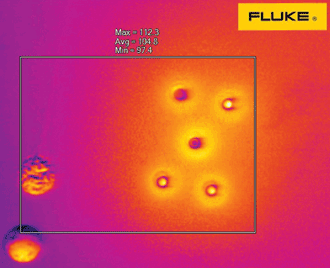
Printed circuit board and microelectronics inspection using an IR macro lens can show uneven solder coverage and irregular contact with the circuit board.
“The development of higher-operating-temperature focal plane arrays and low-power microcoolers is improving cost and resolution for high-performance sensors,” Goodnough said. “This makes them prime candidates for integration on unmanned aerial vehicles and other applications with demanding size, weight and power requirements.”
In addition to the technological advances, gradual changes in export regulations – for example, to the Wassenaar Arrangement, which dictates how conventional arms and dual-use goods and technologies such as infrared imagers can be taken outside of the U.S. – are making the technology more available to broader markets.
“Prior agreements made it very difficult to export thermal imaging camera technology to many corners of the world,” Stuart said. “For U.S. manufacturers such as Fluke that have always made products that appealed to a broad range of users, this agreement expands the international opportunities by appropriately managing access to the technology for friendly signatory countries.”
A final market driver that must not be overlooked is the power to turn measurement data into useful, actionable information, and then to communicate that information more easily to others.
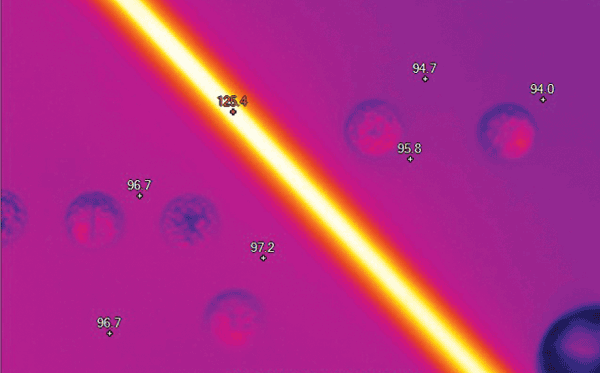
Printed circuit board trace thermal proximity evaluation using an IR macro lens.
With many of today’s thermal imaging systems incorporating modern onboard communications technology, in-field measurements can be sent to and through wireless mobile devices and Web-enabled communications tools.
“The increased access to, and ability to use information from, these infrared cameras, along with information from other types of inspection technologies, has allowed many users to reap significant benefits,” Stuart said.
On the horizon
An emerging application that the experts at Yole Développement are monitoring is the employment of IR technology in personal robotics, typically drones and security robots. Companies such as Knightscope Inc. and EOS Innovations Ltd. have already made announcements in this direction.
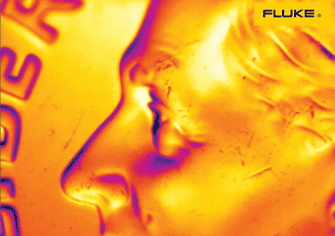
Infrared image of Franklin Delano Roosevelt on the U.S. dime (10 cents) demonstrates microscopic-level IR evaluation detail using a stock handheld camera, paired with an optional macro lens.
Founded in response to the tragic events at Sandy Hook and the Boston Marathon, California-based Knightscope developed an autonomous robot to monitor crowds and assist law enforcement officers. Similarly, EOS Innovation is a French startup developing surveillance robots to patrol warehouses and industrial sites.
But Lockheed Martin’s Goodnough highlights that cost, size, weight and power are still limiting factors when it comes to the platforms that can take advantage of any performance advances.
Performance and cost are expected to continue to improve (perhaps at a slower pace than that experienced for visible detectors). However, it is the superresolution processing algorithms that will provide additional capability, improved sensitivity and spectral flexibility improvements that will take IR imaging to a whole new level of image clarity, detail and multi-depth-of-field focus sharpness.
The Rise of the Smartphone Thermal Camera:
2014 saw a game-changing realization for the IR imaging market: Flir Systems Inc., the leader of uncooled IR imaging, shipped its first Flir One product: the first thermal IR camera to be plugged into an iPhone 5S. By the end of the year, Seek Thermal followed up with its own thermal camera for iOS and Android smartphones.
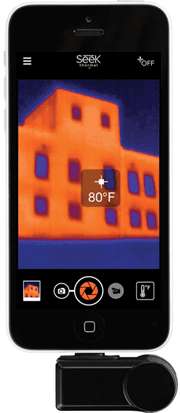
A thermal image of a building façade viewed on a smartphone fitted with an IR camera. Photo courtesy of Seek Thermal.
Seek’s thermal camera is used for applications related to home improvement, personal safety, hunting and boating, and first response equipment. Examples include:
• Identifying leaky windows and doors, insufficient insulation and other sources of energy loss; tracing water damage up a wall or across a ceiling to its source; and identifying the location of clogs in pipes.
• Scanning a dark parking lot before heading to a car at night or scanning a yard for predators before investigating strange noises.
• Measuring the heat distribution across a barbecue or griddle; instantly measuring the surface temperature of food; or detecting the propane level in a gas tank.
• Being able to see people or floating objects in the water, even in total darkness.
“Before those two products came to market, the lowest cost of an IR camera was in the range of $1500,” said Yann de Charentenay, senior analyst, MEMS & Sensors at Yole Développement. “Now, those add-ons are in the range of $200 to $300. One can expect sales in the order of tens of thousands of this new type of consumer IR imaging product in 2015.”